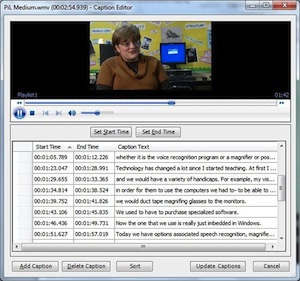News
Microsoft Adds Accessibility Tools to Office 2010

Microsoft's STAMP software includes TTML import support and a basic caption editor for creating subtitles from scratch. |
Microsoft announced betas of two new accessibility tools that work with its Office 2010 productivity suite and also launched new developer resources for creating more accessible Web sites and software.
The tools include two beta add-ons, which were unveiled on Thursday for Office 2010, one for Word and one for PowerPoint. The PowerPoint add-on is a tool called "STAMP" that's used to create captions within PowerPoint or to import existing TTML ("Timed Text Mark-up Language") caption files. Users can format imported TTML captions based on color, alignment and other styling elements. They can also turn captions on and off in presentation mode and adjust the position of captions when a video changes size.
According to Microsoft, faculty members at Towson University in Maryland are using this software "to caption educational presentations that help the hearing disabled and others learn more efficiently."
Microsoft also released an add-on called Save as DAISY, which lets users save Open XML-format documents as DAISY XML and Full DAISY, either from single Open XML files or multiple files. According to the company, "these formats include synchronized text and .MP3 audio that can be played directly within Windows 7 or DAISY XML, which works with compatible software readers and talking book/Braille reading devices."
Both of the new add-ons are available now in beta form.
The releases were announced at the International Technology and Persons with Disabilities Conference in San Diego. They followed recent accusations by the National Federation of the Blind against one of Microsoft's competitors, Google. That group issued a statement on March 15 claiming that Google's Apps for Education, which competes with some of Microsoft's cloud offerings, falls short in the area of accessibility for blind users. The group also called on the U.S. Department of Justice to investigate four public school districts in Oregon and two universities -- New York University and Northwestern University -- that have adopted Google Apps for Education for possible "civil rights violations committed...against blind faculty and students." The group said the apps in the suite contain "significant accessibility barriers for blind people utilizing screen access technology...."
Microsoft has also launched a collection of online resources, software and courses to help developers make their sites and applications more accessible for users with disabilities. Called Microsoft Accessibility Tools & Training, the suite includes seven free training courses, for both technical and nontechnical audiences, covering a range of technologies, including Web and desktop software.
According to the company, "Microsoft initially developed the online tools and training courses to increase accessibility awareness and expertise among its own developer groups. In response to growing customer demand for accessibility guidance, however, Microsoft decided to make the resources available, free of charge, to corporations, governments and nongovernmental organizations (NGOs) around the world that want to make technology more accessible."
Other resources available as part of the Microsoft Accessibility Tools & Training suite include a guide to tools for addressing accessibility issues for various kinds of disabilities, along with links for downloading most of the tools, and content tackling accessible rich Internet applications (ARIAs).
Further information about Microsoft Accessibility Tools & Training and the accessibility add-ons for Office 2010 can be found here.
About the Author
Dave Nagel is the executive editor for 1105 Media's educational technology online publications and electronic newsletters.